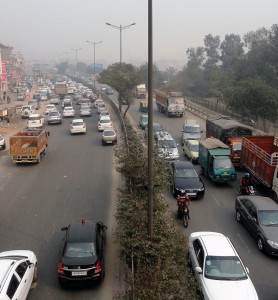LOOKING AT DELHI
 In Delhi, 73% walk, 35% take dedicated walk trips, and 38% use public transport; 35% delhities own cycles but the cycle trips have reduced to 4% because of poor NMT infrastructure and unsafe road conditions. NMT modes are ideal for short trips and as feeder to public transport. The short trips are up to 4kms and make for 60%. Four per cent use cycle and 25 use cycle rickshaws and 35% walk. Delhi is very ideal for NMT because it is well planned and developed.
In Delhi, 73% walk, 35% take dedicated walk trips, and 38% use public transport; 35% delhities own cycles but the cycle trips have reduced to 4% because of poor NMT infrastructure and unsafe road conditions. NMT modes are ideal for short trips and as feeder to public transport. The short trips are up to 4kms and make for 60%. Four per cent use cycle and 25 use cycle rickshaws and 35% walk. Delhi is very ideal for NMT because it is well planned and developed.
Town and Country planning organization has chosen Jasola and Sarita Vihar area for retrofitting. These are upcoming areas with two national highways passing through them. The sites are close to environmentally sensitive places like Okhla Bird Sanctuary, there are residential areas both formal & informal residential areas, Sion Bagh- an unauthorized colony and urban village.
to environmentally sensitive places like Okhla Bird Sanctuary, there are residential areas both formal & informal residential areas, Sion Bagh- an unauthorized colony and urban village.
After doing street audit, 13 roads were identified within this area. We have done urban design and land use analysis, and the traffic impact assessment, and then studied the existing infrastructure on NMT. The retrofitting plan is prepared for each road; what should be the ROW design, the junction design, the traffic re-direction, the component design and the segregated lanes and then finally we have implementation and other action plans because various agencies are involved. We have specified the policies, legal provisions, the people participation model, the financials and the institutional responsibilities.
the policies, legal provisions, the people participation model, the financials and the institutional responsibilities.
The Saheen Bagh on the bank of the Yamuna is un-organized colony, and there is a lot of non-motorized transport. The area has a economically weaker sections and industrial workers, who go across the railway line in the Okhla industrial area and Mohan Cooperative Industrial estate. There is a formal colony Sarita Vihar as well. None of these roads right now have any facilities for the non – motorised transport. The foot paths in most of the cases are not useable because either they are broken or there are obstructions and manholes on the road itself; there are missing paving, open drains, parking is on the pedestrians pathways often, the bus stop also comes on the footpath. There are huge high-tension pylon constructed on the pavement itself, and there are trees planted and electric boxes in the sub-stations. Another factor which we noticed that entire ROW has been paved, but there is no lane marking to indicate the driving area. Wherever the lane marking is there it is normally much more than the standard, normally the lane which should be 3.5mtrs but in many cases we saw the lane is around six to seven meters, so virtually it has no effect on the driving conditions of this area.
The retrofitting plan is prepared for each road; what should be the ROW design, the junction design, the traffic re-direction, the component design and the segregated lanes and then finally we have implementation and other action plans because various agencies are involved.
 NMT track has been designed along all arterial and collector roads. This track run on both sides of the roads or on just one side (double line indicates track on both sides). Two way tracks are indicated in black UI directional tracks are indicated in red stretches highlighted in white are exclusively for NMT traffic. Foot paths run on both sides of the roads other than the stretches in black dots (single side).
NMT track has been designed along all arterial and collector roads. This track run on both sides of the roads or on just one side (double line indicates track on both sides). Two way tracks are indicated in black UI directional tracks are indicated in red stretches highlighted in white are exclusively for NMT traffic. Foot paths run on both sides of the roads other than the stretches in black dots (single side).
JUNCTION DESIGN
Junctions on NH2 are signalised with table top speed regulation mechanisms coupled with a rumble strip junctions on G D Birla Marg are signalised with table top speed regulation mechanisms coupled with a rumble strip. Some intersections have been restricted for motor vehicles or directional controls collector roads have intersections which only have a table top and no signal or rumble strip. Roundabout is retained near Jasola district centre.
In the western countries where 80% people own cars, only 50% of the road space is given to the automobiles and rest of the road space is given to the non-motorized transport. They have a dedicated cycle track, although they don’t have rickshaws. In Delhi, though it has even been a very planned city, it has not been provided with NMT track our study shows that it can very will be, it is feasible, it can be done and because we have large number of non-motorized transport. We have also done further detailing on lighting, intersections, rickshaw stands and multi-utility zone.
 TrafficInfraTech Magazine Linking People Places & Progress
TrafficInfraTech Magazine Linking People Places & Progress



